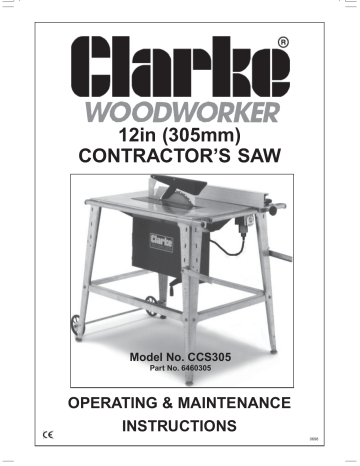advertisement

1.
Raise the blade to its maximum height by using the Blade Height Adjuster
Handle mounted beneath the Lower Blade Guard box.
2.
Place a small square on the table and slide it up to the blade. Check to ensure the blade is square - at 90°.
3.
If adjustment is required, slacken off both Blade Tilt Adjuster knobs slightly, allowing the box to be moved, so that the blade is correctly aligned.
Finally, retighten the adjuster knobs and recheck.
4.
When the blade is square, check to ensure the pointer, mounted on the
Lower Blade Guard Box, is pointing to zero. If necessary, slacken off the pointers’ mounting screw, zero the pointer and retighten the screw.
It should be noted that although an angle gauge is provided so that bevels up to 45° may be produced, it should not be relied upon for absolute accuracy. You should always check with a protractor where absolute accuracy is desired.
B.
The Riving Knife is essential in preventing kickback and producing a good clean cut without chattering or binding taking place.
Before use, check to ensure it is straight and directly in line with the blade, with the correct clearance of 3mm maintained between it and the blade along its full length (see fig. 8 on page 12).
Should the Riving Knife become out of shape or misaligned, it must be gently eased back into line, or if the damage is more severe, it must be removed and bent back into shape accordingly or replaced.
Adjustment is made by slackening off the two securing nuts (within the Lower
Blade Guard Box), moving the Riving Knife to achieve the correct clearance, and finally fully tightening the securing nuts.
C.
Check to ensure the blade teeth are sharp and the blade is sound. If teeth are chipped, or cracks are apparent, the blade must be renewed.
D .
Always check to ensure that the Lower Blade Guard Box and the Lower Blade
Guard Box Cover are firmly secured.
E.
Ensure the Upper Blade Guard is in place, pivots freely, and falls under its own weight.
OPERATION
1. Rip Cutting
You should always set the depth of the blade to the thickness of the wood plus
2mm. i.e. the blade should only just break the surface of the wood. This is to obtain maximum efficiency and to protect and preserve the saw blade teeth, particularly when cutting thin sections.
Blade depth is set by raising or lowering the blade using the adjuster handle mounted beneath the blade guard box.
17
advertisement